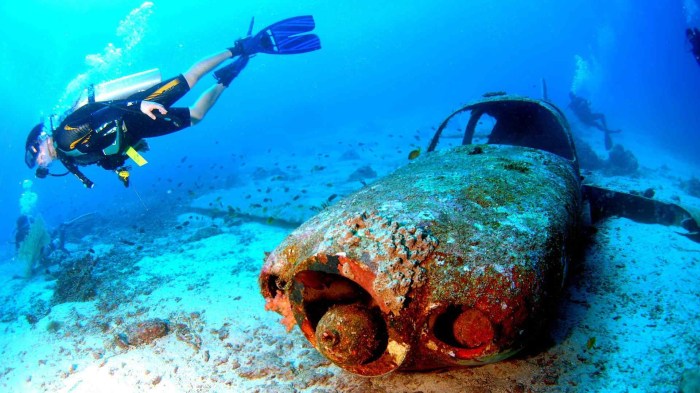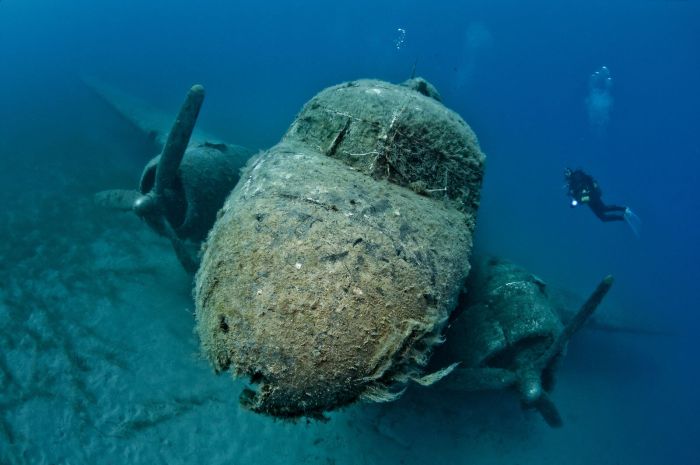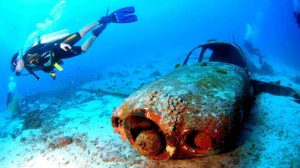
Underwater wreck diving tours offer a unique blend of adventure, history, and exploration. These tours cater to a diverse range of enthusiasts, from seasoned divers seeking thrilling challenges to beginners captivated by the allure of submerged vessels. The experience transcends mere sightseeing; it’s a journey into the past, a chance to witness firsthand the silent stories etched into the metal and coral of sunken ships, and to explore the vibrant ecosystems that have claimed these watery graves.
From the shallow, sun-drenched wrecks of the Caribbean to the deeper, more mysterious remains in the Pacific, each dive site offers a distinct and unforgettable experience.
The global popularity of wreck diving is steadily increasing, driven by a growing interest in underwater exploration and the unique appeal of discovering historical artifacts and marine life coexisting in these unusual environments. This burgeoning sector offers diverse opportunities, ranging from beginner-friendly shallow dives to technically demanding deep-sea expeditions, ensuring accessibility for divers of all skill levels while maintaining an element of thrill and discovery.
Popularity and Trends of Underwater Wreck Diving Tours

Underwater wreck diving, a niche within the broader scuba diving tourism sector, has experienced significant growth and evolving popularity over the past decade. The allure of exploring sunken vessels, uncovering historical mysteries, and encountering unique marine life attracts divers of all experience levels, contributing to a dynamic and expanding market. This exploration delves into the current state of wreck diving tourism, analyzing its popularity, key destinations, growth trends, and comparative appeal.
Global Popularity and Top Destinations
Wreck diving tours are experiencing a global surge in popularity. While precise figures are difficult to obtain due to the fragmented nature of the industry, anecdotal evidence from dive operators and tourism boards suggests a consistent rise in participation. The appeal extends beyond experienced technical divers; increasingly, recreational divers are incorporating wreck dives into their itineraries, fueled by advancements in dive training and equipment making wreck penetration safer and more accessible.
Top destinations consistently include the Red Sea (Egypt), specifically around the wrecks of the SS Thistlegorm and the Rosalie Moller; Truk Lagoon (Micronesia), boasting a large concentration of WWII wrecks; and the Mediterranean Sea, with numerous shipwrecks off the coasts of Greece, Italy, and Malta. Other popular locations include the Caribbean, particularly around Grand Cayman and the Bahamas, known for their shallow, easily accessible wrecks.
Growth Trends Over the Past Five Years
The past five years have witnessed a steady increase in the number of wreck diving tours offered and participants. This growth is partially attributed to the rise of social media, which showcases the breathtaking imagery and unique experiences associated with wreck diving, attracting a broader audience. Furthermore, improved infrastructure in many dive locations, including better access to dive sites and improved safety measures, has made wreck diving more appealing and accessible.
The expansion of liveaboard dive operations, offering multi-day trips to remote wreck sites, has also contributed to this growth. While quantifiable data is limited, observing the expansion of dive operators specifically catering to wreck diving and the increased availability of wreck diving packages across various booking platforms provides strong evidence of this upward trend. For example, many established dive operators have reported a 15-20% increase in wreck dive bookings over the last five years.
Comparative Appeal to Other Underwater Activities
Wreck diving offers a unique blend of adventure, history, and underwater exploration not found in other diving activities. Unlike reef diving, which primarily focuses on observing vibrant coral and fish life, wreck diving presents the opportunity to explore man-made structures, often teeming with unusual marine life that has colonized the wreck. Compared to cave diving, which requires specialized training and equipment, wreck diving offers a more accessible entry point for divers seeking a thrilling and unique underwater experience.
The historical aspect adds another layer of intrigue, allowing divers to connect with the past and learn about the stories behind the sunken vessels. This combination of adventure, historical significance, and unique marine biodiversity sets wreck diving apart from other underwater activities.
Average Cost of Wreck Diving Tours
The cost of wreck diving tours varies significantly based on location, duration, and the level of expertise required. Generally, liveaboard trips are more expensive than day trips. The following table provides a rough estimate of average costs, recognizing that these can fluctuate based on season and specific operators.
| Location | Day Trip (USD) | Liveaboard (USD/day) | Notes |
|---|---|---|---|
| Red Sea (Egypt) | $150-$300 | $300-$600 | Prices vary greatly depending on the specific wreck and operator. |
| Truk Lagoon (Micronesia) | N/A (Mostly Liveaboards) | $400-$800 | Liveaboards are the most common way to experience Truk Lagoon’s wrecks. |
| Grand Cayman | $100-$250 | $250-$500 | Prices vary based on the specific wreck and the level of dive experience required. |
| Malta | $80-$200 | $200-$400 | Many shore dives are available, making this a more budget-friendly option. |
Types of Underwater Wreck Diving Tours
Wreck diving offers a unique and thrilling experience for divers of all levels, from beginners exploring shallow, easily accessible wrecks to experienced divers tackling challenging deep-sea explorations. The variety in wreck diving experiences is vast, influenced by factors like wreck type, depth, water conditions, and geographic location. This section categorizes different wreck diving tours based on difficulty, explores regional variations, and details essential safety measures and equipment.
Wreck Diving Difficulty Levels
Wreck diving difficulty is categorized into beginner, intermediate, and advanced levels, primarily based on depth, visibility, current strength, and the complexity of the wreck itself. Beginner dives typically involve shallow wrecks with easy navigation and minimal current. Intermediate dives might include deeper wrecks or those with slightly more challenging conditions. Advanced dives often involve deep, complex wrecks, strong currents, or limited visibility, requiring specialized training and experience.
For example, a simple, shallow, well-lit wreck in a calm bay might be suitable for beginners, while a deep, partially collapsed wreck in a strong current would be reserved for experienced divers.
Geographic Variations in Wreck Diving
The experience of wreck diving varies significantly based on geographic location. Warm-water wreck diving, often found in tropical and subtropical regions, typically offers excellent visibility and diverse marine life, though potentially stronger currents. Wrecks in these areas may be more heavily colonized with coral and other marine organisms. In contrast, cold-water wreck diving, prevalent in temperate and polar regions, often presents challenges like reduced visibility, colder water temperatures, and potentially stronger currents.
However, cold-water wrecks may exhibit a unique ecosystem and attract different species of marine life, often showcasing a different type of beauty and preservation.
Safety Precautions and Equipment for Wreck Diving
Safety is paramount in wreck diving. Essential equipment includes a dive computer, redundant air supply (e.g., two tanks or a stage bottle), a dive light (primary and backup), a reel or DSMB (delayed surface marker buoy) for navigation and safety, and appropriate buoyancy control devices. Additional considerations for different dive levels include specialized training (e.g., wreck penetration certification), appropriate exposure protection (dry suit for cold water), and the use of penetration lines for safe navigation within the wreck.
Proper planning, briefing, and adherence to established dive procedures are crucial for all wreck dives.
Famous Shipwrecks Popular for Diving
Several famous shipwrecks worldwide attract divers from all over the globe. These include the SS Yongala in Australia, known for its abundant marine life; the USS Oriskany in Florida, a large aircraft carrier; the SS Thistlegorm in the Red Sea, a cargo ship laden with wartime supplies; and the Andrea Doria in the Atlantic Ocean, a luxury liner. The unique history and condition of each wreck contribute to its popularity among divers.
Shallow Wreck vs. Deep Wreck Diving
Shallow wreck dives generally offer easier navigation, better visibility, and less demanding physical exertion. The risk associated with decompression sickness is also significantly reduced. Deep wreck dives, conversely, present more complex challenges, including longer bottom times, increased decompression requirements, and a greater risk of decompression sickness. Visibility may be reduced at greater depths. The added complexity and potential hazards require advanced training, meticulous planning, and careful execution.
The experience of exploring a deep wreck, however, often offers a more profound sense of adventure and discovery, revealing a different aspect of maritime history and marine ecology.
Marketing and Promotion of Underwater Wreck Diving Tours

Successfully marketing underwater wreck diving tours requires a multi-faceted approach that leverages compelling visuals, targeted advertising, and strong online presence. Attracting divers requires showcasing the unique thrill and historical significance of these underwater adventures.
A Marketing Campaign Targeting Potential Wreck Diving Tourists
This campaign will focus on reaching experienced divers seeking unique experiences and adventure, as well as those new to wreck diving who are intrigued by the challenge and history. We’ll utilize a combination of online and offline strategies to maximize reach. The campaign will emphasize the safety and expertise of our dive operators, the historical significance of the wrecks, and the stunning underwater photography and videography.
We will target specific demographics through social media advertising and collaborations with dive travel agencies and influencers. Offline strategies will include partnerships with dive shops and participation in relevant dive shows and exhibitions.
Compelling Descriptions for Different Wreck Diving Tour Packages
Tour packages should be clearly categorized and described to appeal to different skill levels and interests. For example, a “Beginner’s Wreck Dive” package could highlight the shallow depth, easy navigation, and abundant marine life surrounding a specific wreck. This package could be priced competitively and marketed towards divers looking to try wreck diving for the first time. An “Advanced Wreck Penetration” package could focus on a more challenging dive site with potential for deeper penetration, requiring advanced certification.
This package would appeal to experienced divers looking for a more thrilling experience and could be priced higher. Finally, a “Photography & Videography Focused Wreck Dive” package could highlight a specific wreck known for its photogenic qualities and provide professional guidance on underwater photography and videography. This package would attract divers interested in capturing stunning underwater images.
Strategies for Using Social Media to Promote Wreck Diving Tours
Social media platforms, such as Instagram, Facebook, and YouTube, are crucial for showcasing the beauty and excitement of wreck diving. High-quality photos and videos of the wrecks, marine life, and divers exploring the sites are essential. Running targeted ads on these platforms, focusing on demographics interested in diving and adventure travel, will increase visibility. Engaging with followers through comments and direct messages, running contests and giveaways, and collaborating with travel influencers can increase engagement and brand awareness.
Live Q&A sessions with experienced dive masters can address potential concerns and build trust. Utilizing relevant hashtags to increase discoverability is also vital.
The Use of High-Quality Photography and Videography to Showcase Wreck Dives
Professional, high-resolution photography and videography are paramount to effectively marketing wreck diving tours. Images and videos should showcase the unique characteristics of each wreck, including its size, condition, and surrounding marine life. They should also depict the excitement and adventure of the dive experience, highlighting the divers’ interaction with the environment. Using drone footage to capture aerial perspectives of the dive sites can also enhance the visual appeal.
These visuals should be used consistently across all marketing materials, including website, brochures, social media, and advertising campaigns.
Sample Social Media Posts to Promote a Specific Wreck Diving Tour
Post 1 (Instagram): Image: A stunning underwater shot of divers exploring a vibrant coral reef surrounding a shipwreck. Caption: “Explore the mysteries of theSS Neptune*! 🐠 Join us for an unforgettable wreck dive in the crystal-clear waters of [Location]. Book your adventure now! #wreckdiving #scubadiving #underwaterphotography #[Location] #[DiveOperatorName]” Post 2 (Facebook): Video: A short, dynamic video showcasing the excitement of a wreck dive, interspersed with shots of the marine life and the wreck itself.
Caption: “Discover the secrets of the deep! OurSS Neptune* wreck dive offers an unparalleled adventure for experienced divers. Limited spots available – book your place today! [Link to booking page] #wreckdiving #advanceddiving #underwaterworld #[Location]” Post 3 (YouTube): A longer, more detailed video showcasing the history of the
SS Neptune*, the marine life surrounding it, and the diving experience itself, including interviews with divers and dive masters. Caption
“Dive into History: Exploring theSS Neptune* Wreck. [Link to booking page] #wreckdiving #divinghistory #underwateradventure #[Location]”
Comparison with Other Adventure Travel Niches
Underwater wreck diving tours, while a niche adventure activity, share similarities and differences with a range of other travel experiences. Understanding these comparisons helps in targeted marketing and identifying potential customer segments. This section will analyze the key distinctions and overlaps between wreck diving and other popular adventure travel niches.
Underwater Wreck Diving Tours Compared to Religious Pilgrimages
Religious pilgrimages and wreck diving tours, while seemingly disparate, share a common thread: a journey to a significant site holding profound meaning for participants. Pilgrimages focus on spiritual significance, while wreck diving emphasizes historical and archaeological importance. Both involve a degree of preparation, adherence to rules and regulations, and a sense of awe and reverence upon arrival at the destination.
However, the motivations differ greatly; one is spiritual, the other is often exploratory or adventurous. The level of physical exertion also varies significantly, with pilgrimages ranging from contemplative walks to strenuous climbs, while wreck diving requires specific physical fitness and training.
- Shared Aspect: Sense of purpose and achievement upon completion.
- Key Difference: Motivations – spiritual vs. historical/adventurous.
- Key Difference: Physical demands – variable vs. specialized fitness required.
Underwater Wreck Diving Tours Compared to Wildlife Watching
Both underwater wreck diving and wildlife watching involve observing unique aspects of the natural world. Wildlife watching may focus on terrestrial or aquatic animals, while wreck diving offers a glimpse into the underwater ecosystem thriving around a shipwreck. Both require respect for the environment and often involve specialized equipment (binoculars for wildlife, diving gear for wrecks). However, wildlife watching tends to be more passive, while wreck diving is an active pursuit demanding specialized skills and certifications.
The unpredictability of wildlife sightings contrasts with the known, albeit changing, location of a wreck.
- Shared Aspect: Observation of unique natural environments.
- Key Difference: Activity level – passive vs. active.
- Key Difference: Predictability of the experience – highly variable vs. somewhat predictable.
Underwater Wreck Diving Tours Compared to Winter Sports Trips
Winter sports trips and wreck diving tours cater to thrill-seekers, but their environments and required skills differ drastically. Winter sports typically involve snow and ice, while wreck diving takes place underwater. Both necessitate specialized equipment and training, and both carry inherent risks requiring safety precautions. However, the physical demands are different; winter sports often focus on strength and endurance, while wreck diving requires buoyancy control and underwater navigation skills.
The seasonal nature of winter sports contrasts with the year-round possibility (depending on location) of wreck diving.
- Shared Aspect: Appeal to thrill-seekers and adventure enthusiasts.
- Key Difference: Environment – snow/ice vs. underwater.
- Key Difference: Required skills – strength and endurance vs. buoyancy control and underwater navigation.
Underwater Wreck Diving Tours Compared to Island Hopping
Island hopping involves exploring multiple islands, often by boat, while wreck diving focuses on a single site (the wreck). Both can involve travel to remote and beautiful locations. Island hopping often incorporates relaxation and sightseeing, while wreck diving is a more focused, physically demanding activity. The level of planning differs; island hopping involves coordinating travel between islands, while wreck diving requires diving certifications and equipment.
- Shared Aspect: Exploration of beautiful, often remote locations.
- Key Difference: Focus – multiple locations vs. a single site.
- Key Difference: Activity level – relaxed sightseeing vs. active diving.
Underwater Wreck Diving Tours Compared to Voluntourism
Voluntourism combines travel with volunteer work, often focusing on conservation or community development. Wreck diving can involve elements of conservation (e.g., responsible diving practices, reef preservation), but its primary focus is not volunteer work. Voluntourism emphasizes giving back to a community, while wreck diving primarily focuses on personal experience and exploration. The motivations are distinctly different: altruism versus personal adventure.
- Shared Aspect: Potential for environmental conservation.
- Key Difference: Primary focus – volunteer work vs. personal exploration.
- Key Difference: Motivation – altruistic vs. adventurous.
Underwater Wreck Diving Tours Compared to Photography Tours
Photography tours focus on capturing images of specific subjects, which could include underwater scenes. Wreck diving can certainly incorporate photography, but it is not its primary objective. Photography tours often involve instruction and guidance on photography techniques, while wreck diving emphasizes diving skills and safety. Both activities can result in stunning visual records, but the emphasis and skills required are distinct.
- Shared Aspect: Potential for creating stunning visual records.
- Key Difference: Primary focus – photography vs. diving.
- Key Difference: Required skills – photography techniques vs. diving skills and safety procedures.
Underwater Wreck Diving Tours Compared to Festival Travel
Festival travel focuses on attending cultural or musical events, offering a vibrant social experience. Wreck diving is a more solitary and focused activity, although it may be part of a larger group dive. Festival travel is generally centered around a specific event, while wreck diving is site-specific. The atmosphere and pace are vastly different; lively and social vs.
focused and potentially intense.
- Shared Aspect: Potential for a shared group experience (though the nature differs).
- Key Difference: Atmosphere – lively and social vs. focused and potentially intense.
- Key Difference: Focus – cultural/musical event vs. specific dive site.
Underwater Wreck Diving Tours Compared to Desert Expeditions
Desert expeditions and wreck diving tours offer contrasting environments and challenges. Desert expeditions involve navigating arid landscapes, while wreck diving requires underwater navigation and specialized equipment. Both may involve physical challenges and require careful planning and preparation. However, the skills and equipment required are completely different.
- Shared Aspect: Both require careful planning and preparation for challenging environments.
- Key Difference: Environment – arid desert vs. underwater.
- Key Difference: Required skills and equipment – desert navigation and survival vs. diving skills and equipment.
Underwater Wreck Diving Tours Compared to Underwater Adventures (General)
Underwater wreck diving is a specific type of underwater adventure. General underwater adventures might include snorkeling, scuba diving on reefs, or exploring underwater caves. Wreck diving shares the common element of underwater exploration, but it focuses on shipwrecks. The level of expertise required varies; wreck diving often demands more experience and training than other forms of underwater adventure.
- Shared Aspect: Exploration of the underwater world.
- Key Difference: Specific focus – shipwrecks vs. broader underwater environments.
- Key Difference: Required expertise – often more specialized training required.
Underwater Wreck Diving Tours Compared to Art and Architecture Tours
Art and architecture tours focus on appreciating human-created structures above water, while wreck diving involves exploring submerged structures. Both involve appreciation for history and design, but the context and accessibility are vastly different. Art and architecture tours are usually accessible to a wider audience, while wreck diving requires specialized skills and training.
- Shared Aspect: Appreciation of historical structures and design.
- Key Difference: Accessibility – readily accessible vs. requiring specialized skills and training.
- Key Difference: Environment – above water vs. underwater.
Environmental Impact and Sustainability of Wreck Diving
Wreck diving, while a thrilling adventure, carries inherent environmental risks. The very act of visiting these submerged sites, coupled with the potential for human error, can negatively impact fragile marine ecosystems. Understanding these impacts and implementing sustainable practices are crucial for preserving these unique underwater environments for future generations. This section details the environmental considerations of wreck diving and Artikels strategies for responsible exploration.
Environmental Impacts of Wreck Diving Tourism
The environmental impact of wreck diving tourism is multifaceted. Divers can inadvertently damage delicate coral reefs and marine habitats through accidental contact with their equipment or by disturbing sediment. Improper buoyancy control can lead to the dislodging of organisms and the destruction of sensitive structures. The increased presence of divers can also cause stress to marine life, altering their natural behaviors and potentially impacting their reproductive success.
Furthermore, the disposal of waste, such as sunscreen chemicals and discarded equipment, can pollute the water and harm marine organisms. For example, the release of even small amounts of sunscreen containing oxybenzone and octinoxate can damage coral reefs and lead to coral bleaching. Similarly, improperly disposed fishing line can entangle and injure marine animals.
Sustainable Practices for Wreck Diving Operators
Sustainable practices are essential for mitigating the negative impacts of wreck diving. Operators should prioritize environmental education and training for their divers, emphasizing proper buoyancy control, responsible equipment handling, and the importance of minimizing disturbance to marine life. Regular maintenance of equipment, ensuring that it is free from sharp edges or loose parts that could damage the wreck or the surrounding environment, is also vital.
Operators should also implement strict waste management policies, ensuring the proper disposal of all waste materials and discouraging the use of harmful chemicals such as sunscreens containing oxybenzone and octinoxate. Implementing a strict “leave no trace” policy, actively removing any litter found during dives, is a critical aspect of responsible operation. Furthermore, partnering with marine conservation organizations to participate in research and monitoring initiatives can contribute significantly to the long-term health of the dive sites.
The Role of Responsible Tourism in Preserving Marine Ecosystems
Responsible tourism plays a pivotal role in preserving marine ecosystems. This involves educating divers about the fragility of these environments and promoting responsible behavior. This education should cover aspects like maintaining neutral buoyancy, avoiding contact with marine life, and respecting the historical significance of the wrecks. Responsible tourism also includes supporting local communities and businesses that are committed to sustainable practices.
This could involve choosing operators with a proven track record of environmental stewardship and supporting initiatives that promote marine conservation. For example, choosing operators who actively participate in coral reef restoration projects or contribute to marine protected area management demonstrates a commitment to responsible tourism.
Minimizing Disturbance to Marine Life During Wreck Diving
Minimizing disturbance to marine life is paramount. Divers should maintain a safe distance from marine animals and avoid chasing or touching them. Proper buoyancy control is essential to prevent accidental contact with the seabed or any organisms attached to the wreck. Divers should also avoid disturbing sediment, as this can smother benthic organisms and reduce water clarity.
Slow and deliberate movements, avoiding sudden or jerky motions, can help minimize the stress on marine life. For example, avoiding the use of flash photography near sensitive organisms can prevent startling them or causing damage to their delicate tissues.
A Guide for Environmentally Responsible Wreck Diving
Environmentally responsible wreck diving requires a commitment from both divers and operators. This commitment involves:
- Proper buoyancy control to avoid contact with the wreck or seabed.
- Maintaining a safe distance from marine life and refraining from touching or harassing animals.
- Careful handling of equipment to prevent damage to the wreck or surrounding environment.
- Proper disposal of all waste materials.
- Avoiding the use of harmful chemicals such as oxybenzone and octinoxate containing sunscreens.
- Supporting local communities and businesses that are committed to sustainable practices.
- Participating in citizen science initiatives to monitor and protect marine ecosystems.
Following these guidelines ensures the longevity of these unique and historically significant underwater sites while preserving the health of the surrounding marine ecosystems.
Visual Representation of Wreck Diving Tours
Wreck diving offers a unique blend of adventure, history, and breathtaking underwater scenery. Visualizing these tours effectively is key to attracting potential participants and conveying the experience’s richness. This section will explore the visual aspects of a popular wreck dive site and illustrate the stages of a typical tour.
The SS Yongala Wreck: A Visual Masterpiece
The SS Yongala, a passenger and cargo steamship that sank off the coast of Queensland, Australia, in 1911, is a prime example of a visually stunning and historically significant wreck dive site. Imagine descending through the clear, turquoise waters, the sunlight filtering down to illuminate a vast, coral-encrusted hull. Giant groupers and other large fish swim lazily through the skeletal remains of the ship, their scales shimmering in the light.
Schools of smaller fish dart in and out of the intricate network of portholes and corridors, creating a mesmerizing underwater ballet. The ship’s massive propeller, still partially buried in the sand, is a dramatic focal point, while delicate corals have colonized much of the structure, transforming it into an artificial reef teeming with life. The visual impact is extraordinary: a blend of the ship’s decaying grandeur and the vibrant, thriving ecosystem that has claimed it as its own.
The historical significance adds another layer—this was a significant loss of life, and the wreck itself is a silent testament to a bygone era of maritime travel. The haunting beauty of the decaying structure juxtaposed with the vibrant marine life creates a powerful and unforgettable experience.
Stages of a Typical Wreck Diving Tour: A Visual Journey
The visual experience of a wreck diving tour unfolds in stages. First, imagine the pre-dive briefing: a group of divers gathered around a table, studying maps and diagrams of the wreck site, their faces illuminated by the glow of flashlights. The instructor points out key features, emphasizing safety procedures and potential hazards. Then, the divers don their gear—wetsuits, buoyancy compensators, and scuba tanks—transforming into a team of underwater explorers.
The boat ride to the dive site itself is often scenic, offering a chance to appreciate the surrounding ocean landscape. The descent is a gradual transition from the sunlit surface to the increasingly mysterious depths, the light fading as the wreck slowly comes into view. The exploration of the wreck is a visually rich experience, full of unexpected discoveries and close encounters with marine life.
The ascent back to the surface is a gradual return to the sunlight, the divers slowly decompressing and reflecting on their underwater adventure. Finally, back on the boat, the divers share their experiences, their faces flushed with exhilaration and their stories filled with vivid descriptions of the underwater world they just explored. The post-dive relaxation, often accompanied by refreshments and the review of underwater photographs, provides a final opportunity to relive the experience.
Final Wrap-Up
Ultimately, underwater wreck diving tours provide an unparalleled adventure, blending the thrill of exploration with the serenity of the underwater world. Whether you’re a seasoned diver or a curious beginner, the opportunity to explore these submerged time capsules and witness the captivating interplay between history and nature offers a truly enriching and unforgettable experience. The responsible exploration of these sites, however, is paramount to ensure the preservation of these delicate ecosystems and the legacy of the wrecks themselves for future generations of divers.
This responsible approach ensures the continued allure and accessibility of this captivating niche tourism sector.
FAQ Resource
What is the best time of year to go wreck diving?
The ideal time varies by location, depending on water temperature and weather conditions. Research the specific location you are interested in for optimal diving conditions.
What level of diving certification do I need for wreck diving?
Requirements vary depending on the wreck’s depth and complexity. Many shallow wrecks are suitable for certified Open Water divers, but deeper or more challenging wrecks may require Advanced Open Water or even specialized certifications.
What if I’m not a certified diver? Can I still participate?
Yes, many operators offer Discover Scuba Diving experiences or introductory wreck dives for non-certified individuals under the direct supervision of a professional instructor.
What kind of equipment is typically provided on wreck diving tours?
Most operators provide scuba gear, including tanks, regulators, BCD, and wetsuits. However, it’s always best to confirm what is included and what you might need to bring personally.





